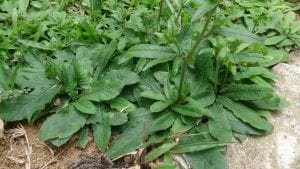Searching for New Mesothelioma Drugs Among African Plants
 Doctors in Cameroon and Turkey say two types of African plants deserve more study as potential treatments for malignant mesothelioma and other intractable cancers.
Doctors in Cameroon and Turkey say two types of African plants deserve more study as potential treatments for malignant mesothelioma and other intractable cancers.
The plants, including Elephantopus mollis,, Kalanchoe crenata, and four other medicinal plants, contain compounds that triggered cell death when tested on mesothelioma cells in the laboratory.
At present, there is no cure for mesothelioma and no drugs that consistently slow its progression. Even the most powerful anti-cancer drugs in use today typically have only a modest effect on this aggressive asbestos-linked malignancy.
Testing Plant Extracts on Mesothelioma Tumor Cells
For their new study, scientists at two Cameroonian universities and Anadolu University in Turkey utilized the methanol extracts from the whole Elephantopus mollis plant (EMW), the bark of the Enantia chlorantha and Lophira alata plants, and the leaves of the Kalanchoe crenata, Millettia macrophylla, and Phragmanthera capitata leaves plants.
All of these plants – which range from low ground weeds to larger evergreens, succulents, and a mistletoe – are used medicinally in Africa to treat a variety of ailments. Several have been the subjects of scientific studies.
To test their utility as anti-cancer agents for malignant mesothelioma and other cancers, researchers first performed a qualitative chemical analysis of each extract. “Phytochemical analysis revealed the presence of polyphenols, triterpenes and sterols in all extracts,” writes lead author Victor Kuete, a biochemist at the University of Dschang in Cameroon.
The extracts were then applied to directly to five different types of drug-resistant human tumor cells, including malignant mesothelioma.
New Drug Sources for Mesothelioma?
To determine what effect these extracts had on different types of tumor cells, the research team analyzed three different parameters: the life cycle stage of the treated cells, the stability of the mitochondrial membranes (known as mitochondrial membrane potential), and the levels of reactive oxygen species (ROS).
Each of these parameters give scientists crucial information about the health and viability of mesothelioma cells. Cells under stress are more likely to enter their death stages earlier, have weaker mitochondrial membranes, and produce more ROS.
What they found is that EMW induced apoptosis or cellular death by reducing mitochondrial membrane potential and increasing ROS production. The leaves of the Kalanchoe crenata plant, a tropical succulent, also induced apoptosis among the pleural mesothelioma cells by stimulating ROS production.
“The study provides evidences of the cytotoxicity of the tested plant extracts and highlights the good activity of Elephantopus mollis and Kalanchoe crenata,” concludes Dr. Kuete. “They deserve more exploration to develop novel cytotoxic drugs.”
While rare, malignant pleural mesothelioma is on the rise in many third-world countries where asbestos regulations may be lax or non-existent. Even in the US, which heavily regulates the use of asbestos, mesothelioma deaths were higher in 2015 than in 1999.
Source:
Kuete, V, et al, “Cytotoxicity of the methanol extracts of Elephantopus mollis, Kalanchoe crenata and 4 other Cameroonian medicinal plants towards human carcinoma cells”, May 25, 2017, BMC Complementary and Alternative Medicine





